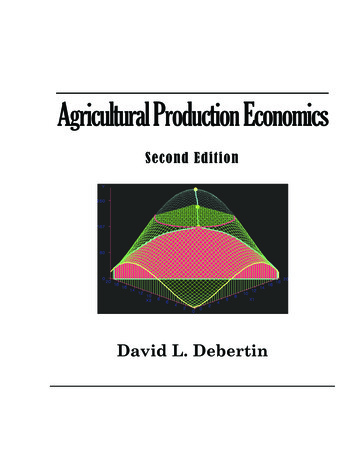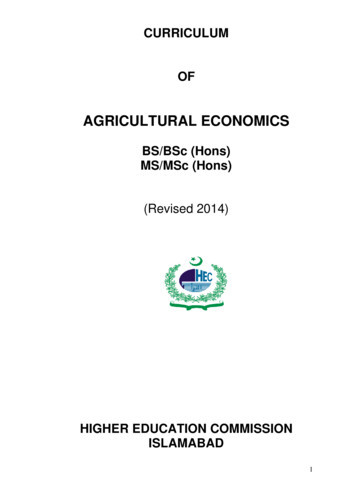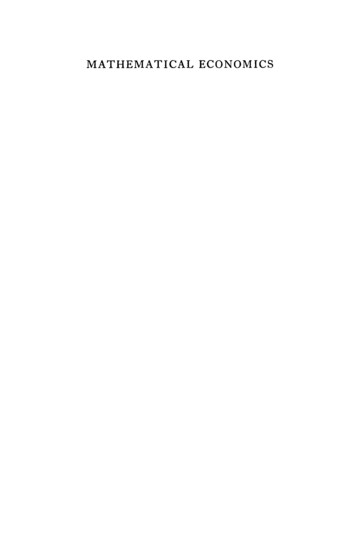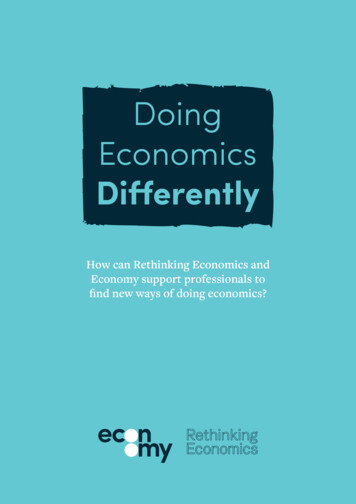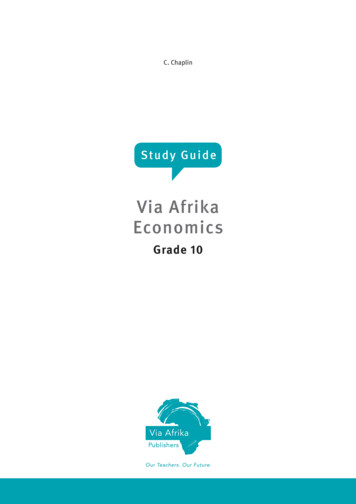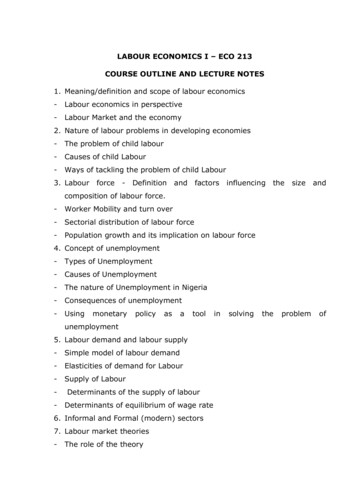
Transcription
1LECTURE NOTESCourse No. AECO 141Principles of Agricultural EconomicsCompiled byDr.N SunandaAssistant ProfessorDepartment of Agricultural EconomicsAcharya N G Ranga Agricultural UniversityAgricultural College, NAIRA
2Lecture no.1Economics – Meaning, Definitions, Subject matter of Economics – Traditionalapproach – consumption, production, exchange and distributionECONOMICSEconomics is popularly known as the “Queen of Social Sciences”. Itstudies economic activities of a man living in a society. Economic activities are thoseactivities, which are concerned with the efficient use of scarce means that can satisfy thewants of man. After the basic needs viz., food, shelter and clothing have been satisfied,the priorities shift towards other wants. Human wants are unlimited, in the sense, that assoon as one want is satisfied another crops up. Most of the means of satisfying thesewants are limited, because their supply is less than demand. These means have alternativeuses; there emerge a problem of choice. Resources being scarce in nature ought to beutilized productively within the available means to derive maximum satisfaction. Theknowledge of economics guides us in making effective decisions. The subject matter ofeconomics is concerned with wants, efforts and satisfaction. In other words, it deals withdecisions regarding the commodities and services to be produced in the economy, how toproduce them most economically and how to provide for the growth of the economy.Subject matter of economicsEconomics has subject mater of its own . Economics tells how a man utilises hislimited resources for the satisfaction of unlimited wants. Man has limited amount of timeand money. He should spend time and money in such away that he derives maximumsatisfaction. A man wants food, clothing and shelter. To get these things he must havemoney. For getting money he must make an effort. Effort leads to satisfaction. Thus,wants- efforts- satisfaction sums up the subject mater of economics initially in a primitivesociety where the connection between wants efforts and satisfaction is direct .Divisions of EconomicsThe subject matter of economics can beexplained under two approachesviz.,Traditional approach and Modern approach.Traditional ApproachIt considered economics as a science of wealth and divided it into four divisionsviz., consumption, production, exchange and distribution1. Consumption: It means the use of wealth to satisfy human wants. It also meansthe destruction of utility or use of commodities and services to satisfy humanwants.2. Production: It is defined as the creation of utility. It involves the processes andmethods employed in transformation of tangible inputs (raw materials, semi-
3finished goods, or subassemblies) and intangible inputs (ideas, information, know-how) into goods or services.3. Exchange:It implies the transfer of goods from one person to the other. It mayoccur among individuals or countries. The exchange of goods leads to an increasein the welfare of the individuals through creation of higher utilities for goods andservices.4. Distribution: Distribution refers to sharing of wealth that is produced among thedifferent factors of production .It refers to personal distribution and functionaldistribution of income. Personal distribution relates to the forces governing thedistribution of income and wealth among the various individuals of a country.Functional distribution or factor share distribution explains the share of totalincome received by each factor of production viz., land, labour, capital andorganisation.Lecture No.2Modern Approach – Microeconomics and macroeconomics - Methods of economicinvestigation – Deduction & , InductionModern Approach :This approach divides subject matter of economics into two divisions i.e., microeconomics and macro economics. The terms „micro-„ and „macro-„ economics were firstcoined and used by Ragnar Frisch in 1933.1. Micro-Economics or Price Theory:The term „micro-economics‟ is derived from the Greek word „micro‟, which means smallor a millionth part. It is also known as „price theory‟. It is an analysis of the behaviour ofsmall decision-making unit, such as a firm, or an industry, or a consumer, etc. It studiesonly the employment in a firm or in an industry. It also studies the flow of economicresources or factors of production from the resource owners to business firms and theflow of goods and services from the business firms to households.It studies thecomposition of such flows and how the prices of goods and services in the flow aredetermined.A noteworthy feature of micro-approach is that, while conducting economicanalysis on a micro basis, generally an assumption of „full employment‟ in the economyas a whole is made. On that assumption, the economic problem is mainly that of resourceallocation or of theory of price.Importance of Micro-Economics: Micro-economics occupies a very important place inthe study of economic theory. Functioning of free enterprise economy: It explains the functioning of a freeenterprise economy. It tells us how millions of consumers and producers in aneconomy take decisions about the allocation of productive resources among millionsof goods and services.
4 Distribution of goods and services: It also explains how through market mechanismgoods and services produced in the economy are distributed. Determination of prices: It also explains the determination of the relative prices ofvarious products and productive services. Efficiency in consumption and production: It explains the conditions of efficiencyboth in consumption and production. Formulation of economic policies: It helps inthe formulation of economic policies calculated to promote efficiency in productionand the welfare of the masses.Limitations of Micro-Economics: Micro-economic analysis suffers from certainlimitations: It does not give an idea of the functioning of the economy as a whole. It fails toanalyse the aggregate employment level of the economy, aggregate demand, inflation,gross domestic product, etc. It assumes the existence of „full employment‟ in the whole economy, which ispractically impossible.2. Macro-Economics or Theory of Income and Employment:The term „macro-economics‟ is derived from the Greek word „macro‟, which means“large”. Macro-economics is an analysis of aggregates and averages pertaing to theentire economy, such as national income, gross domestic product, total employment, totaloutput, total consumption, aggregate demand, aggregate supply, etc. Macro-economicslooks to the nation's total economic activity to determine economic policy and promoteeconomic progress.Importance of Macro-Economics: It is helpful in understanding the functioning of a complicated economic system. Italso studies the functioning of global economy. With growth of globalisation andWTO regime, the study of macro-economics has become more important. It is very important in the formulation of useful economic policies for the nation toremove the problems of unemployment, inflation, rising prices and poverty. Through macro-economics, the national income can be estimated and regulated. Theper capita income and the people‟s living standard are also estimated through macroeconomic study.Limitations of Macro-Economics: Individual is ignored altogether. For example, in macro-economics national saving isincreased through increasing tax on consumption, which directly affects the consumerwelfare. The macro-economic analysis overlooks individual differences. For instance, thegeneral price level may be stable, but the prices of food grains may have gone upwhich ruin the poor. A steep rise in manufactured articles may conceal a calamitous
5fall in agricultural prices, while the average prices were steady. The agriculturistsmay be ruined.DEFINITIONS OF ECONOMICSThe word economics has been derived from the Greek Word “OIKONOMICAS” with “OIKOS” meaning a household and “ NOMOS” meaning management. Kautilya, thegreat Indian statesman, named his book on state crafts as „Arthashastra‟.WEALTH DEFINITION OF ECONOMICS : Adam smith defined Economics as “An enquiry into the nature and causes of wealth of nations” in his book, entitled „ Wealthof Nations‟. He is regarded as the “Father of Economics”.Criticisms of Adam smith definition:WELFARE DEFINITION OF ECONOMICS :Alfred Marshall in his book“Principles of Economics” defined “Political Economy or Economics as a study ofmankind in the ordinary business of life, it examines that part of individual and socialaction which is most closely connected with the attainment and with the use of thematerial requisites of well- being . Thus it is on the one side a study of wealth, and onthe other, and more important side, a part of the study of man.Criticisms of Alfred Marshall definition:SCARCITY DEFINITION OF ECONOMICS:Significance of Economic Science‟ Lionel RobbinsIn his publication „Nature andformulated his conception ofEconomics based on the scarcity concept. “Economics is the science which studieshuman behaviour as a relationship between ends and scarce means which have alternativeuses.GROWTH DEFINITION OF ECONOMICS: John Maynard Keynes is known as theFather of Modern Economics. He defined economics as “the study of the administrationof scarce resources and of the determinants of employment and income”.In the words of Nobel prize winner Prof. Samuelson, “Economics is the study of howpeople and society end up choosing with or without the use of money, to employ scarceproductive resources that could have alternative uses, it produces various commoditiesover time and distributes them for consumption, now or in the future, among variouspersons and groups in society. It analyses costs and benefits of improving patterns ofresources allocation.”ImportanceEconomics analyses the economic problems of the society. It plays a major role in theeconomic development of the country by proposing the optimum allocation of resources.
6Knowledge of economics is useful in understanding various national and internationalevents and trends.Amarthya Sen, Bharat Ratna recipient was awarded Nobel Prize for Economics.Methods of Economics Investigation :There are two methods of economic investigation that are used in economictheory i.e., 1) Deductive method and 2) Inductive Method1. Deductive Method:This method involves reasoning or inference fromthe general to the particular or from the universal to the individuals. It isalso known as the abstract, analytical, hypothetical or apriori method.Deduction involves four steps:(1) Selecting the problems(2) Formulating the assumptions(3) Formulating the hypothesis through the process of logical reasoning wherebyinferences are drawn and(4) Verifying the hypothesis.2. Inductive Method: This method is also known as Concrete method,historical method or realistic method. It involves reasoning from particulars to the generalor from the individual to the universal. This method derives economic generalisations onthe basis of experiments and observations. In this method detailed data are collected oncertain economic phenomenon and effort is then made to arrive at certain generalizationswhich follow from the observations collected.Is Economics a Science or an ArtScience is a systematized body of knowledge in which the facts are so arrangedthat they speak for themselves. Judged by this standard, economics is certainly ascience.Economics is also an art because it lays down precepts or formulas to guidepeople to reach their goals.Economics therefore is a science as well as an art.Economics – A Social Science
7Economics deal with the activities of people living in an organized communityor society, in such activities which relate to the earning and use of wealth or with theproblems of scarcity, choice and exchange. Hence it called a social science.Positive Economics and Normative Economics:1. Positive economics is concerned with „what is‟ whereas Normative economics isconcerned with „what ought to be‟.2. Positive economics describe economic behaviours without any value judgment whilenormative economics evaluate them with moral judgment.3. Positive economics is objective while normative economics is subjective.4. The statement, “ Price rise as demand increase” is related to positive economics,whereas the statement, “ Rising prices is a social evil” is related to normative economics.Lecture No.3Agricultural Economics – Definitions, Meaning, Importance of AgriculturalEconomics – Branches of agricultural economicsAGRICULTURAL ECONOMICSIntroductionA study of economic principles, with emphasis on their application to the solution offarm, agribusiness, and agricultural industry problems in relationship to other sectors isknown as Agricultural Economics. In other words, it applies principles of economics toissues of agricultural production, natural resources, and rural development. It mainlyfocuses on principles of microeconomics.Agricultural economics began in the 19th century as a way to apply economicprinciples and research methods to crop production and livestock management. The rootsof the discipline, however, can be found in the writings of the classical economists likeAdam Smith.The word, agriculture comes from the Latin word ager, referring to the soil andcultura, to its cultivation. Agriculture, in its widest sense can be defined as the cultivationand /or production of crop plants or livestock products. It is synonymous with farming:the field or field –dependent production of food, fodder and industrial organic materials.Having known the meaning of agriculture, let us know what economics is.Economics is the science that studies as to how people choose to use scarce productive
8resources to produce various goods and to distribute these goods to various members ofsociety for their consumption. Now having defined agriculture and economics, we lookinto the field of agricultural economics.DefinitionAgricultural economics is an applied field of economics in which the principles ofchoice are applied in the use of scarce resources such as land, labour, capital andmanagement in farming and allied activities. It deals with the principles that help thefarmer in the efficient use of land, labour and capital. Its role is evident in offeringpracticable solutions in using scarce resources of the farmers for maximization ofincome.Prof. Gray has defined agricultural economics as “The science in which theprinciples and methods of economics are applied to the special conditions of agriculturalindustry”According to Prof.Hibbard, “Agricultural economics is the study of relationshipsarising from the wealth-getting and wealth-using activity of man in agriculture”Snodgras and Wallace defined agricultural economics as “an applied phase ofsocial science of economics in which attention is given to all aspects of problems relatedto agriculture.”Importance of agricultural economicsAkin to economics, the field of agricultural economics finds to seek relevance betweencause and effect using the most advanced methods viz, production functions andprogramming models. It uses theoretical concepts of economics to provide answers to theproblems of agriculture and agribusiness. Initially earnest efforts were made by theeconomists to use the economic theory to agricultural problems. Now the subject mattersof agricultural economics is enriched in many directions and fields taking the relevanttools of sciences particularly mathematics and statistics. Agricultural depression whichoccurred in last quarter of 19th century and middle of 20th century brought aboutincreased attention and concern to find out plausible cause and solutions for worldagricultural depression. Here in this context the contribution made by agronomists,economists, horticulturists, etc., is noteworthy. Agriculture is the integral part of theworld food system, having the foundation links between crops and animal productionsystem. Agricultural economists here have to play a major role in understanding theintricacies involved in the foundation systems. Knowledge regarding problems inproduction, finance, marketing and government policies and their impact on productionand distribution is very essential to find out suitable solutions for the farm hesubjectdisciplinesviz.,
ioneconomics,farmmanagement, agricultural marketing etc., to fulfill the requirements.Lecture No.4.Agricultural production economics- Meaning- Definitions- Subject matter –Objectives - Farm Management – Meaning – scope – Definitions- ObjectivesAgricultural production economicsAgricultural production economics is a field of specialization within the subject ofAgricultural Economics. It is concern with the selection of production pattern andresource use efficiency in order to optimize the objective function of farming communityor the nation within a frame work of limited resources. The goals of agriculturalproduction economics are:(1) To provide guidance to individual farmers in using their resources mostefficiently and(2) To facilitate the most efficient use of resources from the stand point of economy.DefinitionAgricultural production economics is an applied field of science wherein theprinciples of choice are applied to the use of capital, labour, land and managementresources in the farming industry.Subject matterAgricultural production economics involves analysis of production relationships andprinciples of rational decisions in order to optimize the use of farm resources onindividual farms and to rationalize the use of inputs from nation‟s point of view. Theprimary interest is applying economic logic to problems that occur in agriculture.Agricultural production economics is concerned with the productivity of inputs.As a study of resource productivity, it deals with resource use efficiency, resourcecombination, resource allocation, resource management and resource administration.The subject matter of production economics involves topics like factor-productrelationship, factor-factor relationship and product- product relationship, size of farm,returns to scale, credit and risk and uncertainty, etc.Objectives:
101.To determine and outline the conditions which give the optimum use of capital,labour, land and management resources in the production of crops and livestock.2. To determine the extent to which the existing use of resources deviates from theoptimum use.3. To analyse the forces which condition existing production pattern and resourceuse.4. To explain means and methods in getting from the existing use to optimum use ofresources.Farm managementIn the context of increased accent on commercialization there is a greater need toimprove the managerial abilities of the farmers. So far the managers in general haveresponded admirably to technological changes that occurred in Indian agriculture. Butresponse of some of the farmers is not in line with needed direction. We can alwaysdifferentiate those farmers performing against those not performing. Hence, it is ofparamount importance for the farm managers to identify the changes that take place andrespond suitably, for any lapse on his part does not help him to survive in the changingeconomy. This speaks of the need for the managers to sharpen the skills to tackle varyingproblems that crop up from time to time in the organization of farm business.The role of farm management, therefore, is to supply the information from thefarmers for sound planning. All farm management tools are helpful to the farmers insolving their managerial problems for successful operation of the farm business.ScopeFarm management is considered to fall in the field of microeconomics. It treats everyfarm as separate unit because of differences in the ability of resources, problems andpotentiality. The main concern of farm management is the farm as a unit. Farmmanagement deals with the allocation of inputs at the level of individual farms. Theobjective of farm management is to maximize returns from the farm as a whole. It isinterested in the profitability along with practicability. What crops, livestock enterprisesand their combination to grow, what amount of resources to be applied, how the variousfarm activity to be performed, etc., all these fall within the scope of farm management.DefinitionsFarm management is defined as the science that deals with organization and operation ofthe farm in the context of efficiency and continuous profits (J. N.Efferson)Farm management is defined as the art of managing a farm successfully as measured bythe test of profitableness (Gray)Farm management is a branch of agricultural economics, which deals with wealth earningand wealth spending activities of farmer in relation to the organization and operation of
11the individual farm unit for securing maximum possible net income (Bradford andJhonson)Objectives1. To examine production pattern and resource use on the farm.2. To identify the factors responsible for the present production pattern and resourceuse on the farm.3. To determine the conditions of optimality in the resource use and the productionpattern on the farm.4. To analyse the extent of sub optimality in the resource use on the farm, and5. To suggest ways and means in getting the present use of resources to optimalityon the farm.Lecture No.5Agricultural finance – Meaning – Definitions – micro vs macro finance –need foragricultural finance-Agricultural marketing – meaning, definition , importance ofagricultural marketingAgricultural financeAgricultural finance generally means studying, examining and analyzing thefinancial aspects pertaining to farm business, which is the core sector of the country. Thefinancial aspects include money matters relating to production of agricultural productsand their disposal.According to Murray (1953), “It is an economic study of borrowing finds by farmers; ofthe organization and operation of farm lending agencies, and of society‟s interest in creditfor agriculture.”According to Tandon and Dhandyal (1962), “as a branch of agricultural economics,which deals with the provision, and management of bank services and financial resourcesrelated to individual farm units”Micro Vs Macro financeAgricultural finance is viewed both at macro level and micro level. Macro financedeals with the different sources of raising funds for agriculture as a whole in the economyand it is also concern with the lending procedures, rules, regulations, monitoring and
12controlling procedures of different agricultural institutions. Thus, macro finance pertainsto financial agriculture at the aggregate.Micro finance deals with financing the individual farm business units and it isconcern with the study as to how the individual farmer considers various sources of creditto be borrowed from each source and how he allocates the same among the alternativeuses within the farm.Need for agricultural financeGiven the requirement of finance in agricultural sector, very few farmers will havecapital of their own to invest in agriculture. Therefore, a need arises to provide credit toall those farmers who require it. Even if we look into the expenditure pattern of the farmfamilies, they have hardly any savings to fall back on. Therefore, credit enables thefarmers to advantageously use seeds, fertilizers, irrigation, machinery, etc. Farmer has toinvariably search for a source which supplies adequate farm credit. Above all, small andmarginal farmers constitute majority of the farming community.Agricultural MarketingThe term, agricultural marketing implies selling of goods and services by the farmers andranchers. It includes various functions viz., assembling, transportation, storing, buying,selling, standardization, grading, processing, sales promotion, etc.According to Thomsen, “agricultural marketing comprises all the operations, andthe agencies conducting them involved in the movement of farm produced foods, rawmaterials and their derivatives, such as textiles, from the farms to the final consumer andeffects of such operations on farmers, middlemen and consumers.”Importance of agricultural marketingMarketing gives signals to increase production and thereby ensures the availability ofgoods, and services. If the marketing activity is developed, demand for goods increases asa result, production of goods also increases. Due to increased production, the demand forinputs increases i.e., demand for input is derived from the increase in demand for theoutput. To distribute the required input to the farm sector, the input marketing has to bestrengthened.Lecture No.6Basic terms and concepts in economics – Goods & Services – free and economicgoods, Utility – Cardinal and Ordinal approaches. Characteristics of utility - Formsof utility.BASIC TERMS AND CONCEPTS IN ECONOMICS
13GOODS and SERVICESEconomics is concerned with the production and distribution of goods and services.Goods: It is defined as anything that satisfies human wants or needs.Characteristic features of goods:1. They are tangible in nature2. They are the material outcome of productionExample: Foodgrains, Machinery, Seeds, Fertilizers etc.,Services would be the performance of any duties or work for another or professionalactivity. .Characteristic Features of Services:1. They are intangible2. Non- Materialistic3. Inseparable4. Variable5. PerishableExample: Services rendered by agricultural labourers, doctors, teachers etc.,Classification of GoodsThe goods are classified based on supply, durability, consumption and transferability.1) Based on Supply: The goods are categorized as economic goods and free goods basedon the supply criteriaFree goods are those goods that exist in lenty that can be used as much as we like. Theyare gifts of nature and used without payment Example: Air, sunshine etc.The economic goods, on the other hand, are scarce and can be had only on payment.They are limited and generally man- made and hence those can be available only onpayment. In Economics, we are concerned with economic goods only. Economic goodsmean wealth.Thus there would have been no science of economics if all goods had been free goods.The distinction between free goods and economic goods, of course is not permanent, forinstance air is a free good but when we receive it under fan it is an economic good.2) Based on Consumption: The Goods are categorized as Consumer goods and ProducerGoods.
14Consumer goods are those which yield, satisfaction directly. They are used by consumerdirectly to satisfy the wants Example: food, clothing, etc. These goods are known as theGoods of First order.Producer goods are these goods which help us to produce other goods. They givesatisfaction indirectly by producing other goods which will yield final satisfaction.Example: machinery, tools etc. They are also termed goods of the second order.3) Based on Durability: This classification emphasized on the nature of the goods andtheir usage.Mono Period Goods are those goods which can be used only once in the production andconsumption process. Example: Seeds, Fertilizers,food etc.,Poly Period Goods are those which can be used repeatedly during the production andconsumption process over several periods. Example:refrigerator machinery, implementsetc.,4) Based on Transferability:External Material Transferable good. Example: Land, Buildings etc.,External material non-Transferable good. Example: Degree Certificate, PAN Card etc.,External non material transferable good. Example: Goodwill of a businessExternal non material Non-transferable good. Example: Friendship,lightInternal non material Non-Transferable good. Example: Intelligence Quotient ,ability,cruelty etc.,
15CLASSIFICATION OF onsumerGoodsProducerGoodsDURABILITYMonoPeriod goodsTRANSFERABILITYPolyExternalInternalPeriod goodsMaterialTransferablegoodsNon- Transferablegoodsnon materialNon - transferablegoodstransferable goods
16UTILITYThe basis of consumer behaviour is that people tend to choose those goodsand services they value high. Based on this premise economists developed the notion ofutility to describe the consumption patterns adopted by the consumers.Definition :Utility means the power to satisfy a human want. Any commodity orservice which can satisfy a human want is said to have utilityCharacteristics of Utility :1. Utility is subjective: Utility varies from person to person, for Eg:- A high yieldingvariety seed gives more utility to the farmer. The same seed provided to a clothmerchant gives zero utility.2. Utility varies with purpose : For Eg:- Coconut oil is used as coking oil or hair oil oras lubricant.3. Utility varies with time :The Intensity of a person‟s desire for a commodity isdifferent at various time periods, for Eg:- Labour requirement for paddy is peakduring transplantation harvesting and threshing period than other operations takenup in paddy cultivation.4. Utility varies with ownership :Ownership of a good creates greater utility from agood than when it is hired Eg:- owning a tractors gives more utility than hiring it.5. Utility need not be synonymous with pleasure: For Eg:- A sick man has to consumemedicines for getting cured. He does not get pleasure during the process.6. Utility does not mean satisfaction:utility is distinct from satisfaction. It impliespotentiality of satisfaction in a given commodity. But the satisfaction is the end resultof consumption. Satisfaction is what we get and the utility is the quality in agoodwhich gives satisfaction.KINDS OR TYPES OF UTILITYThe kinds or types of utilities are 1) Form utility 2) Place utility 3) Time utility and4) Possession utility.1. Form Utility : The Change in the form offers greater utility to the good than in itsoriginal form. For example: Processing of paddy into rice. Rice, fetches superior pricethan paddy because of processing.2. Place Utility : The utility obtained by spatial movement of the good
1. Positive economics is concerned with „what is‟ whereas Normative economics is concerned with „what ought to be‟. 2. Positive economics describe economic behaviours without any value judgment while normative economics evaluate them with moral judgment. 3. Positive economics is objective while normative economics is subjective. 4.

